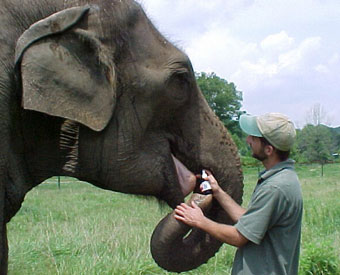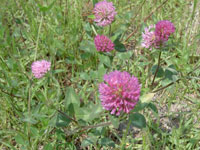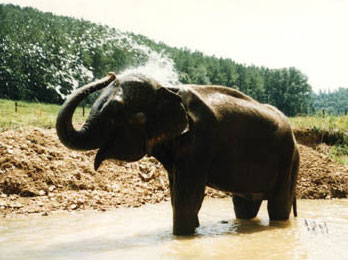Human Flower Project
Saturday, March 04, 2006
Barbara’s Tale
With help from flower essences, a wounded Asian elephant found her trumpet in the hills of Tennessee.

Co-founder and operations director Scott Blais
serves flower essence to Winkie, September 2000
Photo: Carol Buckley, The Elephant Sanctuary in Tennessee
What do you do keep an elephant from dying of sadness?
That’s what Carol Buckley and her associates were up against when they met Barbara in 1997. This 31 year old Asian elephant had been kidnapped at age 2, then sold to an American circus to do a few dumb tricks and spend 18 hours a day chained in a stall.
“At fourteen years of age Barbara and the other elephants were retired to a breeding farm in Florida. During this time Barbara began to lose weight,” though the vets couldn’t explain why. “Barbara suffered with this weight loss condition for the next twelve years, ultimately losing a total of 2000 pounds. Several baby elephants were born during this time, but none to Barbara.”
In 1997, Barbara had the good fortune to come onto The Elephant Sanctuary in Hohenwald, Tennessee. Sanctuary director Carol Buckley, seeing Barbara’s pitiful condition, called in Sharon Callahan, an expert in flower essences who works intensively with non-human animals. Sharon and the Sanctuary staff began administering floral tinctures to Barbara and other elephants on the farm.
 Red Clover
Red Clover
Photo: all in one
First they gave the animals a formula of “Star of Bethlehem, Morning Glory, Comfrey, Arnica, Fringed Violet and St. John’s Wort,” with a shot of red clover—a tincture for traumatized creatures. Other floral remedies followed.
Carol Buckley said that “after the first treatment, all three elephants would open their mouths and stick out their tongues” when she approached with the essence bottles. Buckley goes on to tell us: “We have used flower essences for nearly 10 years and the results are consistent and astonishing. They do work in not so subtle ways.”
If, like us, you tend toward skepticism, shake that off long enough to read Barbara’s tale, to hear how a barren and emaciated elephant trumpeted for the first time March 1, 1997. If nothing else, you’ll get your first chance to see an elephant in a Patagonia parka.
The full subject of flower essences lies well beyond our range of expertise, or even concerted experimentation. Herbalism in general, of course, has been a pancultural approach to healing since ancient times, but flower essences were popularized only in the 1930s, by an English physician named Dr. Edward Bach.
“Disease will never be cured or eradicated by present materialistic methods,” Bach wrote, “for the simple reason that disease in its origin is not material . . . Disease is in essence the result of conflict between the Soul and Mind and will never be eradicated except by spiritual and mental effort.” For Bach, this effort came into focus through tinctures of flowers.
As we understand it, flower essences are believed to revitalize personality, whether human or elephant. One account says that after taking in the essence of certain flowers, “the patient would easily shake off his fears and worries, and with them the disease from which his body suffered.”
 Barbara enjoys a spray
Barbara enjoys a spray
Photo: Carol Buckley
The Elephant Sanctuary
Hohenwald, Tennessee
Dubious? Consider this report that 16 hospitals across Australia now use such remedies.
Then consider Barbara. She died May 18, 2001. And we have every reason, floral and otherwise, to believe she was restored to happiness in her last five years, down on the farm in Tennessee.
(Carol Buckley writes that elephants enjoy eating some flowers, too, “A favorite is the large purple flower on top of the thistle weed.”)




